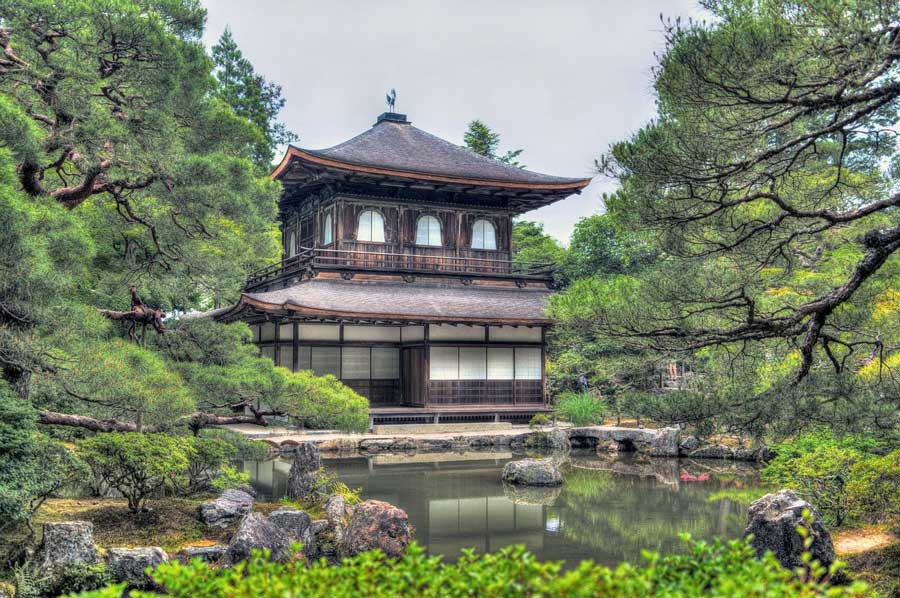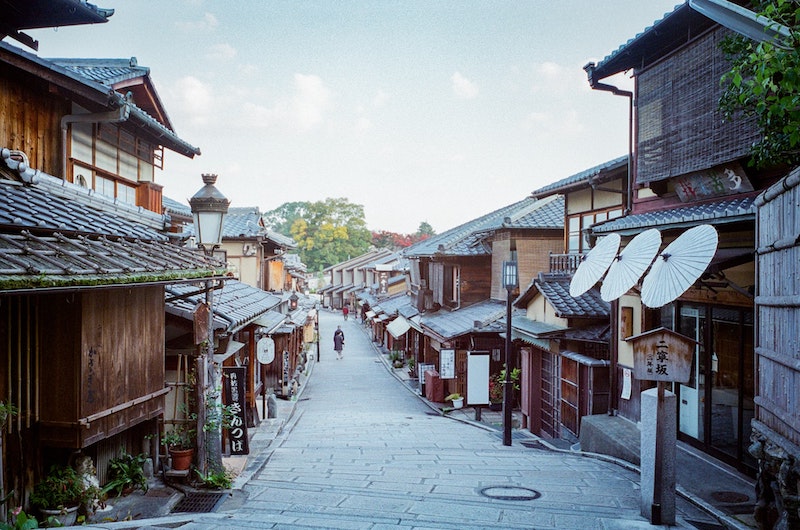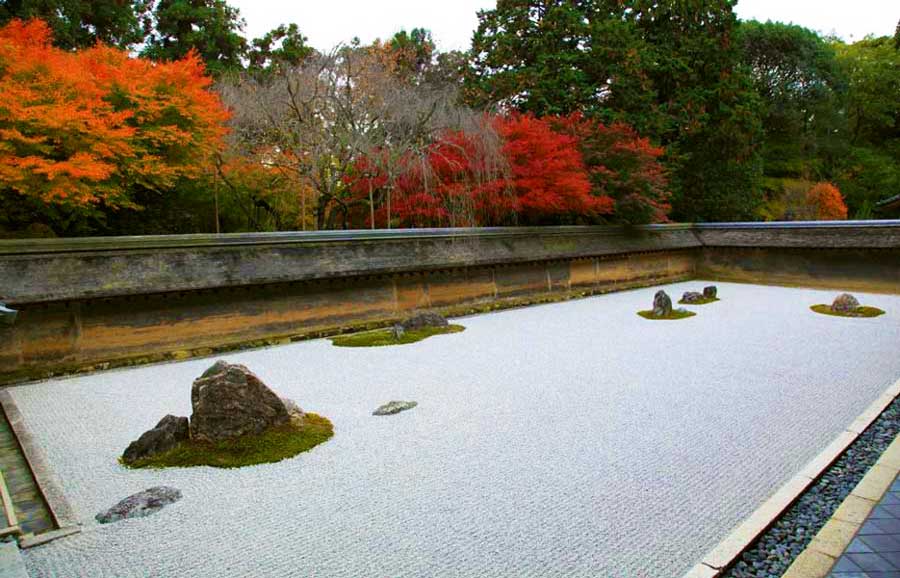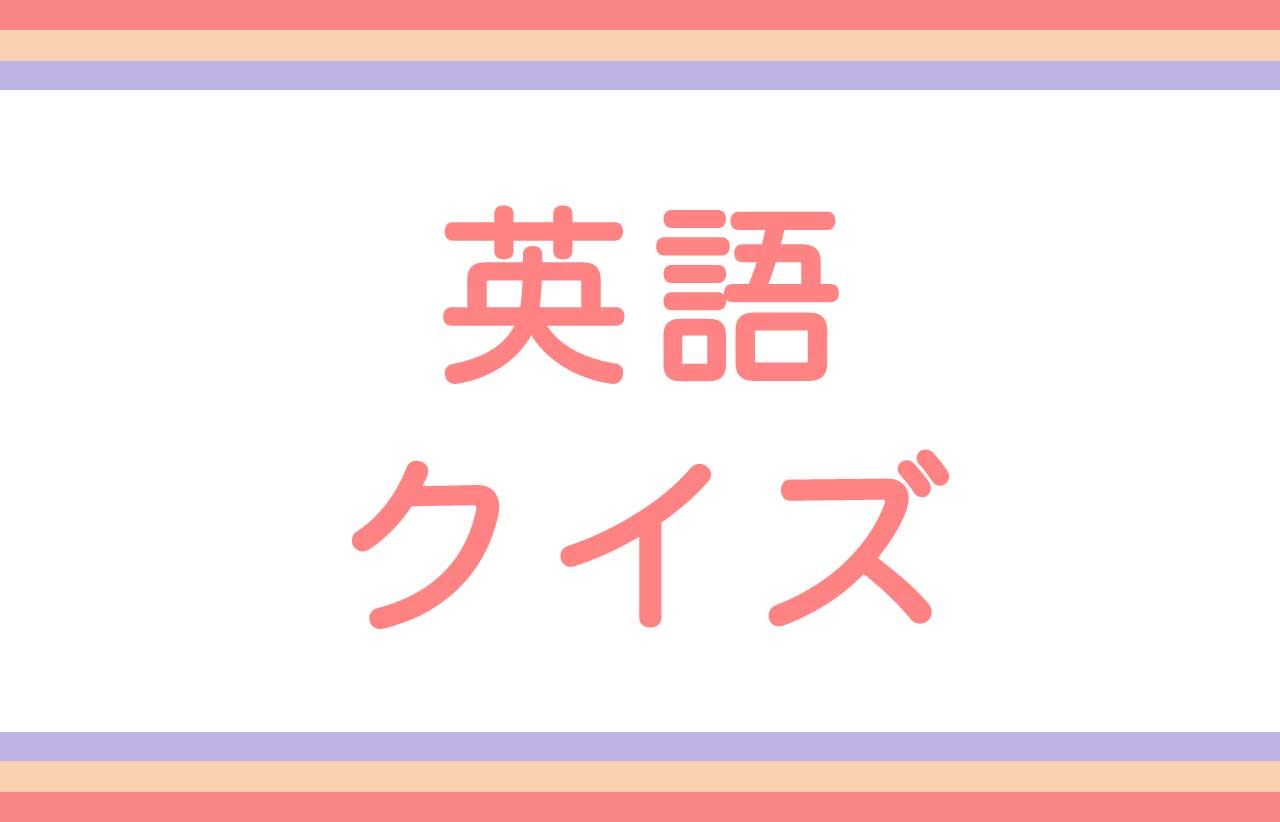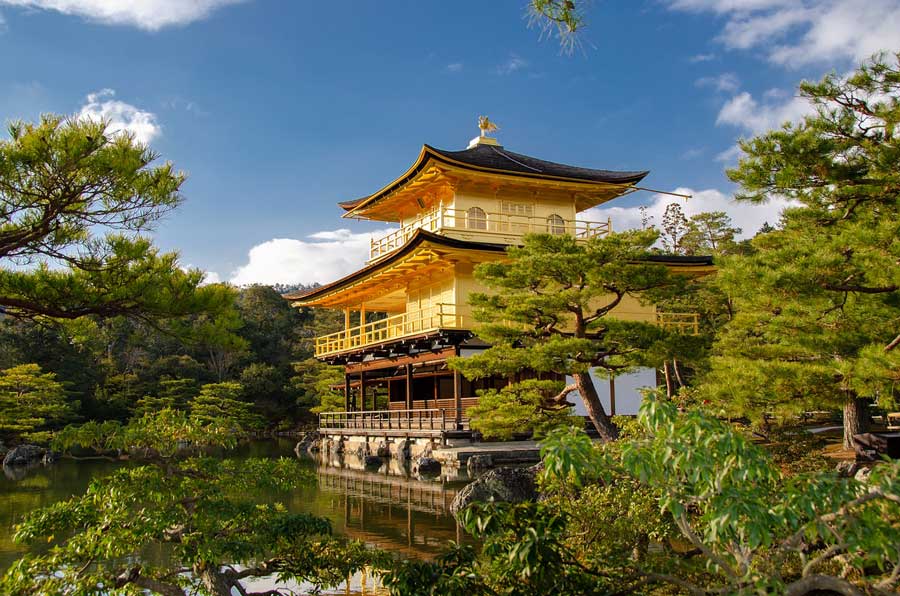
世界で最も有名なお寺のひとつ、金閣寺。
正式名称は「鹿苑寺」で、建物の内外に金箔が貼られた舎利殿「金閣」があり、豊かな緑に囲まれたこの煌びやかな姿と、それを映す鏡湖池とが相まって、誰もがその優美さに驚くのではないでしょうか。
そんな金閣寺を簡単な英語で説明する表現をご紹介していきます。
ご興味のある方は、当サイトで 英語クイズ(5000問) を出題しておりますので是非ご覧ください。
目次
金閣寺へのアクセス
Kinkaku-ji can be accessed from Kyoto Station by direct Kyoto City buses #101 (Stand B2) or #205 (Stand B3). Be careful, there is another service called Rapid #205 that doesn’t reach Kinkaku-ji.
(金閣寺へは、京都駅から直行の京都市バス101系統または205系統で行くことができます。快速205系統は金閣寺へは行きませんので注意してください。)
You can also take Raku Bus #102. Each of these buses stops at the “Kinkakuji-Michi” bus stop, a trip of about 40 minutes.
(洛バス102系統を利用して行くこともできます。いずれも京都駅から40分ほどでバス停「金閣寺道」に着きます。)
Kinkaku-ji Temple is located in the far northwest of Kyoto, and there are no major train lines near that area.
(金閣寺は京都の北西端にあり、その近くに主要な列車の路線はありません。)
Kitanohakubaicho can be said to be the closest station to Kinkaku-ji, the starting point (number B9) on the Kitano Line, which is operated by Keifuku Electric Railroad Co. But it takes a 25-minute walk from the station to Kinkaku-ji.
(金閣寺の最寄駅といえるのは京福電鉄北野線の起点である北野白梅町ですが、駅からは徒歩で25分ほどかかります。)
A visit to Kinkaku-ji Temple can easily be combined with nearby Ryoan-ji Temple, Tojiin Temple, and Ninna-ji. A short walk south from Kinkaku-ji will bring you to both Hirano Shrine and Kitano Tenmangu.
(金閣寺を訪れると、そこから近くの龍安寺や等持院、仁和寺などにも簡単に行くことができます。金閣寺から少し南に歩けば、平野神社や北野天満宮があります。)
金閣寺の見どころ

金閣寺を敢えて英訳する場合は、the Golden Pavilion が一般的です。
Kinkaku-ji is one of the most popular tourist attractions in all of Japan, let alone Kyoto.
(京都ではもちろんのこと、金閣寺は日本で最も人気のある観光スポットのひとつです。)
The official name of Kinkaku-ji is “Rokuon-ji” and Kinkaku is part of a Zen Buddhist temple complex.
(金閣寺の正式名は「鹿苑寺」で、金閣は禅寺の建物の一部です。)
The temple’s Gold Pavilion covered in gold leaf is very distinctive.
(金箔で覆われた金閣が際立っています。)
“Kinkaku” means golden hall, and the hall is covered with real gold leaf.
(金閣とは、金の楼閣を意味し、本物の金箔で覆われています。)
Kinkaku-ji is a three-story building, and the second and third floors are covered with gold.
(金閣寺は3層からなる建物で、2階と3階は金箔で覆われています。)
The three-story pavilion is covered in gold leaf and features a bronze phoenix on top of the roof.
(この3階建ての建物は金箔で覆われており、屋根の上に鳳凰の像が載っているのが特徴です。)
Kinkaku-ji is a combination of three different designs. The first floor was built in Shindenzukuri, the style of a noble family’s palace in the Heian Period, and contains an altar with the images of Amida and Yoshimitsu.
(金閣寺は3つの異なる様式でできています。1階は神殿造りで、阿弥陀如来像と義満像の祭壇があります。)
The second floor was created in Bukezukuri, the style of a samurai’s house, and displays the images of Sho Kannon and Shitenno (the Four Devas).
(2階は武家造りで、聖観世音像と四天王像があります。)
The third floor was built in Zen temple style and houses sacred relics of Buddha.
(3階は仏殿形式で、仏舎利が安置されています。)
In most such reliquaries, including the Kinkaku, the relics are not genuine ashes. Instead, some sacred items are made of gold, jade, and other jewels.
(金閣を含むほとんどの仏舎利は本物ではなく、金や翡翠などの宝石が仏舎利箱に納められてます。)
You can enjoy the beautiful reflection of the pavilion on “Kyoko-chi (the mirror lake pond)” on a windless and sunny day.
(風のない晴れた日には、鏡湖池に映った楼閣の美しい姿を楽しむことが出来ます。)
A “Mirror Lake Pond” is one of the very important parts of a Japanese garden and can be seen in many other places.
(鏡湖池は日本庭園の大切な要素のひとつであり、他にも多くの場所で見ることができます。)
The wooded areas surrounding the temple are very welcoming and great for walking.
(建物の周りの木々が茂ったエリアはとても心地良く、お散歩に最適です。)
When winter comes, Kinkaku-ji will be covered with snow. This scenery is so beautiful that it has become famous all over the world.
(冬になると、金閣寺に雪が積もります。この景色はとても美しく、世界中に知られています。)
The original building was destroyed by arson in 1950 and rebuilt five years later.
(もともとの建物は1950年に放火により焼失しましたが、その5年後に再建されました。)
金閣寺と足利義満
One of the best places to visit is Kinkaku-ji, which was built by Shogun Ashikaga Yoshimitsu in 1397.
(京都の見どころのひとつ金閣寺は、1397年に足利義満が建てたものです。)
Kinkaku-ji was originally built in the 14th century as a villa for Shogun Ashikaga Yoshimitsu.
(最初の金閣寺は14世紀、将軍足利義満の別荘として建造されました。)
Part of the villa called “Kitayama-dono,” built by Shōgun “Ashikaga Yoshimitsu” as a residence and retirement home, was used for entertaining guests.
(金閣は、足利義満によって建てられた北山殿という山荘の一部で、彼はここを住居とし、訪問客の接待場所として使ったりしていました。)
In accordance/compliance with his wishes, the villa was converted into a Zen temple, Rokuon-ji, and sacred relics of Buddha have been kept there since.
(義満の遺言により、北山殿は禅宗寺院鹿苑寺となり、金閣は仏の遺骨を安置する舎利殿となりました。)
The supreme visible symbol of the cultural aspirations of Yoshimitsu is the Kinkaku at his retirement mansion.
(義満の目指した文化的理想を目に見える最高のかたちで表したのが金閣です。)
The first floor was built in “Shindenzukuri,” the style of an aristocratic palace in the Heian period, the second floor in “Bukezukuri,” the style of a samurai’s house, and the third floor in Zen temple style.
(1階は寝殿造り、2階は武家造り、3階は仏殿風になっています。)
The first floor shows aristocratic aspirations as he sought power exceeding that of the Emperor. The second floor expresses the authority of the Shogun, the leader of warriors. The third floor reflects that Yoshimitsu was a follower of Zen Buddhism.
(1階の寝殿造は天皇を超える権力を手に入れようとした義満の貴族志向を、2階の武家造は彼の将軍としての権威を、そして3階の仏殿は義満が禅宗に帰依したことを表しています。)
In Addition, the building is topped with a bronze phoenix (hōō) ornament.
(さらに、金閣の上には鳳凰の像が載っています。)
The phoenix is a legendary bird believed to appear only when the right ruler reigns over a country.
(鳳凰は、正しい為政者が政治を行っているときにのみ出現すると信じられている伝説の霊鳥です。)
By placing a phoenix atop the Kinkaku, Yoshimitsu must have intended to show that he had gained power exceeding that of the Emperor.
(義満は、金閣の上に鳳凰を置くことで、天皇を超える力を得たことを示す目的もあったのでしょう。)
